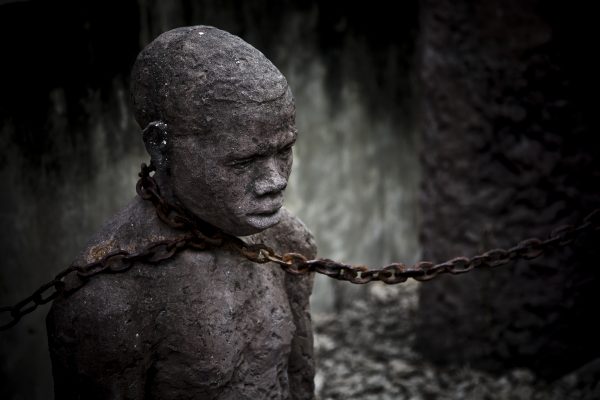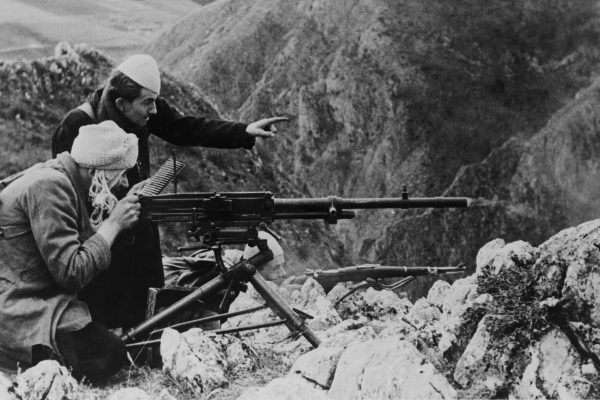Abdullah Quilliam, or as his name then was William Henry Quilliam, suspiciously left a house, 30 Great Prescot Street, with another equally suspicious man who held a suspicious black bag. They were heading towards the London Underground, specifically Mark Lane Station. It was a 10-minute walk. They reached the pub, called Minories, and took a left turning towards the station.
Unbeknown to both of them, two constables were hot on their heels from the moment they left the house. Quilliam and the man descended the steps and were stopped by the two constables and arrested on 9/3/1885, at 11pm [1]. “They are dynamiters!” said someone from the crowd. “Yeah, the black bag contains dynamites!” said another.
What happened to Quilliam and why was he arrested requires preliminary knowledge. So, it’s time to rewind.
William Henry Quilliam was born on the 10th of April, 1856, just a year before the Indian Uprising, in Elliot-street, Liverpool [2]. His great uncle, John Quiliam, fought in the battle of Trafalgar [3] whilst his father eventually became a watch manufacturer [4].
From a young age, he showed signs of intelligence which won him several awards and certificates, or in his words (he wrote in the third person), “many prizes and certificates, and also distinguished himself in the Oxford and Cambridge local, and the Government Science and Art examinations” [5]. He decided to study law and was eventually articled to William Radcliffe, who was also the mayor of Liverpool, to train as a solicitor and within a few years he became a qualified solicitor and was admitted into the Supreme Court [6].
Quilliam would later go on to create a string of firms, but eventually they were all dissolved. The names of the cases that Quilliam participated in were glamorous to say the least. It’s as if Arthur Conan Doyle was inspired by the names of Quilliam’s cases: The Rock Ferry Murder, Etheus de Tomanzie (aka “the black doctor”), the Redcross-street mystery, and the Amusing Dog were just some of the case names [7]. When Quilliam chased after wayward husbands to force them to share their wages with their poverty-stricken family, it inexorably reminds me of John Watson, mixing with the drunkards just to track down Isa Whitney in the story of The Man with the Twisted Lip [8].
Whilst he was occupied with his legal work, he was also occupied with the temperance movement, in which its adherents wished to abolish alcohol completely. From “the tender age of 7” [9], Quilliam signed the pledge to abstain from alcohol and drugs for the rest of his life and indeed he did. Just four years before his death, he was in Cairo and in 1928 he gave a speech in English to an Arab audience, exhorting them about abstaining from alcohol for he saw alcohol being sold in Egypt [10].
Busy with legal cases and the temperance movement, he wrote various articles in the The Templar (formerly called Bugle Call), Liverpool Monthly Magazine [11], and other periodicals. But that is not all, he also became a member of the Liverpool Geological Society and in November of 1878 he, along with three other fellows, were elected as “Ordinary Members of the Society” [12]. In 1880, Quilliam participated in the Conservative Party picnic in Hooton Park in Cheshire. It appears that Quilliam always supported the Conservative Party [13], and was one of the executive committee members. Ah Quilliam, just see how your party ended up [14]!
With “immense application, perseverance, and untiring energy” [15], Quilliam did all the four tasks mentioned above: working as a solicitor, advocating teetotalism (abstaining from alcohol), writing articles, and participating in Conservative Party events (and many more things I did not mention).
And then apparently for no reason, in 1883, he decided to travel.
In 1883, we see Quilliam in Gibraltar. Presumably he was there to do geological work. He placed his foot on the “shark-fin mountain in the sea”, called Jabal Tariq, which 1172 years ago, Tariq ibn Ziyad, the “Berber ex-slave of the son of a Christian ex-slave”, also placed his foot there and looked towards Spain with a vision; a vision of liberation, conquest, and power. Ibn Ziyad supposedly said to his soldiers:
“Men, where can you fly when the sea is behind you and the enemy before you? All you can do is be true and steadfast. For you must know that in this island you are more lost than orphans at the feasts of evil men…” [16].
Unlike Ibn Ziyad, Quilliam had no vision besides studying the flora and fauna of the tiny yet rich in history peninsula. Better than nothing, I guess.
Quilliam described in fascinating detail the geography of the rock, the surrounding region and two of its many caves: St Michael, St Martin, Poca Roca, and others. Once you enter the cave of St Michael, you see “fine stalactite pillars” 50 feet in height! He observed the animals of the present: rabbits, monkeys, lizards, centipedes, snakes and eagles; and of the past, fossilised in time and space: “goat, ox, ibex and other mammals; remains of birds, reptiles and fish.” Human remains, like “…stone axes and daggers, armlets and anklets, worked bone needles, spoons and hair pins; flint knives… querns, rulstones, charcoal…”
However, it is remarkable that Quilliam does not make any mention of the Engis skull. He describes its mythological past in which Hercules separated the Mons Calpe (the rock of Gibraltar) from the Mons Abyla (Jebel Musa, the mount of Musa in Morocco) and its real history, a “great volcanic disturbances…” which split asunder the two lands, opening up the modern Strait of Gibraltar or as it’s known “Bab-ez-Zakak”. He said that were “456 species of flowering plants and ferns indigenous” which “our botanical friends will find… rich and varied”. He saw the O’Hara’s Tower, which would be destroyed 5 years later after Quilliam set foot on Gibraltar and mentioned that “above the Moorish Castle, a perfect human skeleton was also discovered, but the miners blew it into pieces”[17]. How very thoughtful.
After his trip to Gibraltar, Quilliam returned to Liverpool and resumed working for the rest of 1883 and into 1884 in legal work and other things. Quilliam fell ill, and this time the doctor advised him to go to a warm country, Spain, and perhaps specifically Jabal Tariq [18]. He went there again but this time he crossed to Morocco.
Unfortunately, Quilliam didn’t say much about his stay in Morocco [19] in comparison to the description of Gibraltar. But in his 1928 speech, he said:
I saw some Moroccan Hajjis scooping up water from the sea and using it carefully and scrupulously to wash themselves. The ship set sail and as soon as it left the port, these Hajjis stood neatly together in a line and started to do the prayer, in full submission and tranquillity – they were not at all troubled by the force of the strong wind, or by the swaying of the ship. I was deeply touched by the look on their faces and their expressions, which displayed complete trust and sincerity. I was intrigued and became very interested to acquire knowledge and learn about their religion and those who believe in it.”
This and the general morality of the population of Morocco left a puissant impression in his mind. It kept him cogitated to the extent that he (writing in third person again) “…studied the Koran, and every work he could procure upon the subject, either pro or con, and the more he read and considered the matter, the greater became his conviction in the truth of the religion”. In 1884, he converted to Islam in Morocco [20]. What was supposed to be a mere convalesce period turned Quilliam’s world upside down for the rest of his life in every possible unimaginable way. So much for his convalesce!
He packed his bags again and returned to Liverpool [21]. In Liverpool, now as a Muslim, he saw and understood life in a profoundly different way.
The remainder of 1884 was full of legal cases in which he participated in: W. H. Davis forging Quilliam’s signature to obtain money; Mary Owens committing bigamy; Alice Corrin was arrested by a police officer because he thought she was a prostitute but she wasn’t and she won £20 in reparation, the officer refused to apologise; a scandal in St Jude’s Church, and many more cases [22].
Weeks before the beginning of January 1885, James Gilbert Cunningham and Patrick Henehan arrived in London. The former pretended to be a mere American tourist who, on 24/1/1885, left a bomb to explode in the White Tower (Tower of London) whilst the latter already detonated Victoria Station in February of 1884. Both of them were now in London and both were finally arrested [23]. After their arrest, “a large man with a muffler covering his mouth and nose and who spoke with a strong North American accent” [24] approached Quilliam in the dead of night asking him to defend the two dynamiters. Quilliam agreed.
The case was recorded everywhere, and no newspaper failed to mention the “outrage”. Eventually both Cunningham and Henehan were charged with treason. Quilliam, for whatever reason, went to Cunningham’s former house, at 30 Great Prescot Street, where a number of constables were stationed there for the last few weeks to observe who enters and leaves the house.
They saw Quilliam, who they did not know was Quilliam and a suspicious man holding a portmanteau, who was a witness helping Quilliam by carrying his bag. After 6 hours of their arrest at the station, they were freed after the police realised they were innocent. “Both prisoners seemed amused at their adventure, and Mr Quilliam proceeded to Liverpool by the 5:15 a.m. train” [25]. He headed back to Liverpool safe and sound.
(I have left out many details about Quilliam’s early life: his marriage, his children, many legal cases, or even the influence of his grandfather who was an amazing character. So, this article does no justice to his fascinating life nor was it intended to, but was merely an ode to the intriguing life of one of Britain’s most famous converts to Islam).
References
- Shields Daily News 10/3/85, p. 4; Manchester Evening News 10/3/85, p. 3, Nottingham Evening Post, 10/3/85, p. 3. Manchester Courier and Lancashire General Advertiser, 11/3/85, p. 7.
- Quilliam, W. H. 1891. Islam in England. The Religious Review of Reviews. 1(3): 159-166 [164].
- Manchester Courier and Lancashire General Advertiser, 28/10/1899, p. 9.
- Geaves. p. 23.
- Ref 2. Some of the prizes were recorded in the newspapers, for example at the age of 10, he received a certificate and followed by a prize. See Liverpool Daily Post 16/6/1866, p. 7 and Liverpool Daily Post 22/12/1866, p. 7. And at the age of 15 he received a prize Liverpool Mercury 17/6/1871, p. 6.
- Ref 2.
- Respectively, see Liverpool Echo 2/5/1889, p. 3, Cheshire Observer 10/4/1886, p. 3, Cardiff Times 9/3/1895, p. 5, Manchester Courier and Lancashire General Advertiser 8/12/1883, p. 11. Up to date, no one has yet listed all the cases Quilliam participated in or even given a detailed analysis of some of the cases. Since I am not a lawyer, much of the legal jargon is beyond me to comprehend.
- Amazingly in the same magazine, the Strand Magazine, in which Doyle published his Sherlock stories, Quilliam’s friend, Rafiuddin Ahmad, would also publish something about the Ottoman or Mughal Empire in the same issue. For example, straight after The Adventure of the Final Problem, you would see Ahmad’s The Sultan of Turkey with Sultan Abdulhamid II’s well known photo, in which he looks directly into the camera quite crestfallen, perhaps an indication to the collapse of the Empire, slightly composed on the chair with a pair of gloves clenched in his right hand, printed in front of the article.
- Seddon, M. S. 2017. Abdullah Quilliam: A Muslim Revolutionary Socialst? In Gilham, J & Geaves, R. 2017. Victorian Muslim: Abdullah Quilliam and Islam in the West. C. Hurst & Co. pp. 7-23 [9].
- For English transcript, click here and Arabic transcript, click here.
- Ref 2, p. 166.
- Proceedings of the Liverpool Geological Society. Session the Twentieth 1878-9. Part 1. Vol 4. Liverpool, UK: C. Tinling & Co. p. 3.
- Liverpool Mercury 6/9/1880, p. 7; Birt, Yahya. 2018. The Quilliams, Popular Conservatism & the new Trade Unionism in Liverpool. The Islamic Review Special Edition. This is certainly not the only time he participated in a Conservative event. Many other newspapers mention his name explicitly. For example, in 1882, a Mr Forwood visited the “Conservative Club” and Quilliam was among the audience, see Liverpool Mercury 30/11/1882, p. 6. In 1880, Quilliam attended a Conservative demonstration where he was part of the “platform”, see Liverpool Mercury 4/8/1880, p. 6.
- Warsi, Sayeeda. 2017. The Enemy Within. Penguin.
- Birt, Y. 2017. Preachers, Patriots and Islamists. In Gilham, J & Geaves, R. 2017. Victorian Muslim: Abdullah Quilliam and Islam in the West. C. Hurst & Co. pp. 133-150 [p. 133].
- All three quotes were taken from Mackintosh-Smith, T. 2019. Arabs: A 3000-Year History of Peoples, Tribes and Empires. Yale University Press. p. 254.
- Quilliam, W. H. 1886. Gibraltar. Liverpool Geological Association. Transactions. Vol 4. Session 1885-6. Liverpool, UK: Henry Young. pp. 68-78. He may have also gone to Morocco but that is not definite from the text but hinted.
- See ref. 10.
- Quilliam wrote an article about his “Two Months In Morocco” but up until now, I cannot gain access to it. The article will most surely contain interesting facts and shed light to Quilliam’s stay in Morocco. However, since Quilliam went more than once to Morocco, this article may well refer to Quilliam’s stay post-1884 and therefore the article is irrelevant in this context.
- Ref 2, p. 162. Other reference(s) attest to such a story, see Webb, Alexander Russell. 1893. Preaching Islamism in America. Current Literature. Vol 14. No. 3. p. 468. However, how can one who stayed in Morocco for about a month “procure” many books on Islam and studied the Quran and then decide to convert? It seems unlikely but not impossible. Perhaps Quilliam was a fast reader or perhaps it is a mistake on Quilliam’s part and therefore he converted in England and not in Morocco. Quilliam’s practice of Islam does prove that, at least initially, he didn’t know much about Islam and therefore he may well have converted very quickly in Morocco. Allah knows best.
- There are other stories about when Quilliam went to Gibraltar and Morocco. Since I do not intend to describe in detail how I arrived to such an opinion, I simply shared a story that I believe is better supported by the evidences. In sha Allah I will write an independent article explaining why I think that my version of the story is better supported by the evidences available.
- See respectively, Liverpool Echo 14/5/1884, p. 4, Manchester Courier and Lancashire General Advertiser 7/6/1884, p. 15 and Cheshire Observer 19/7/1884, p. 3, Liverpool Mercury 9/5/1884, p. 6.
- For a more detailed account of Cunningham, Heneham and other dynamiters, see Kenna, Shane. 2013. War In The Shadows. Merrion Press.
- Geaves, p. 31.
- Exeter and Plymouth Gazette Daily Telegrams 11/3/1885, p. 3. The newspaper portrays Quilliam as a smoker but that is highly unlikely, in fact it’s impossible.





